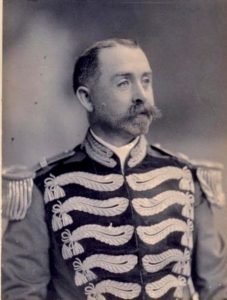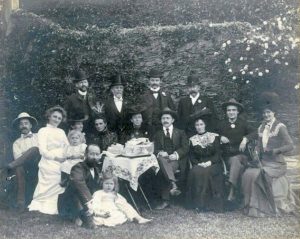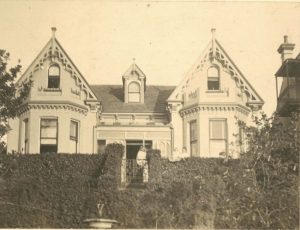Danish consul Ludolph Marcker lived in three houses in Glebe/Forest Lodge: 16 Lodge St, 77 St Johns Rd and 8 Kennedy St. The second address became no. 155 after Denman St was incorporated into St Johns Rd, and the third became 49 Leichhardt St after Kennedy St was similarly absorbed. The Gothic-style mansion on the Johnstons Bay waterfront was built by architect Ambrose Thornley Jr who lived there and christened it Florence Villa. Marcker bought it in 1902 and renamed it Bornholm after his birthplace, the Danish island east of Copenhagen.
The eighth and youngest child of a Bornholm merchant, Marcker left home at age 15 and worked in chemists’ shops in Viborg and Copenhagen. In December 1887, he disembarked in Sydney from the steamship Orient after sailing from London as a second-class saloon passenger. As was common, he gave his profession as ‘gentle

man’. He stayed with his storekeeper uncle Jorgen Fog in Coonamble, but when Fog was declared bankrupt, Marcker moved to Burwood where he went into partnership with chemist Francis Henry Newth.
After he was naturalised as a NSW citizen in 1894, Marcker joined the gold rush to Coolgardie WA. He made enough to cover his living expenses and, keeping his first nugget as a souvenir, returned to Sydney in January 1895 as a cabin passenger on the coastal steamer Adelaide. Later that year he married, in Glebe, Danish-born Emma Emilie Marie Petersen following her divorce from insolvent watchmaker Niels Christian Ulrik Rasch on the grounds of desertion.
The newlyweds lived in Lodge St before moving to 77 St Johns Rd, which they also named Bornholm, and where their first two daughters were born in 1897 and 1900: Jenny Karna Myee and Emilie Bjørg Myee. In 1903 Dagmar Sophie Myee was born at the second Bornholm. Its stables housed a horse and carriage, which took the family to the Blue Mountains for summer holidays.

Licensed as both chemist and druggist and wine and spirit merchant, Marcker registered L. W. Marcker & Co. as Wynyard Lane agents and importers. Among the items they brought into Australia from Copenhagen was Tuberculin, a glycerine extract used to diagnose tuberculosis in cattle and pigs. The product came to be known as ‘Marcker’s lymph’. On a business trip to Christchurch NZ in 1909, Ludolph Marcker met Ernest Shackleton and his exploration team who had just arrived from Antarctica. In Sydney, he was a member of the Danish Club and a social and professional associate of patent medicine manufacturer Hans Peter Rasmussen, a fellow Dane.
In August 1904, Marcker succeeded Theodor Boesen as consul for Denmark, an appointment celebrated with a banquet in Sydney’s Strand Café, festooned with bunting and Danish flags and a portrait of the monarch in pride of place. The guest of honour was greeted with a guard of honour singing the Danish national anthem; entertainment was provided by the Scandinavian Quartette. When King Christian IX died two years later, Marcker organised a memorial service in St Andrew’s Cathedral, its interior draped in purple. Although it was the height of summer, Marcker, in a heavy gold-trimmed uniform hung with a sword, was among the consuls who chose to wear ceremonial dress.

Bornholm, Glebe Point, c. 1905 (photo: Bornholms Museum)
Marcker was not without his enemies, some taking umbrage at his self-description as ‘Royal Danish Consul’, implying he was in the top tier of society while other diplomats were of a lesser rank. There was also unease about perceived efforts to have the Clap Finale Danish dance performed at Government House balls.
Emma Marcker accompanied her husband to social events and busied herself with charitable activities. She joined other Scandinavian residents in raising funds to endow a cot at the Glebe Children’s Hospital and was on the Ladies’ Sanitary Association Committee, which delivered lectures on housekeeping and disease prevention to poorer communities and lobbied for public conveniences for women. She sold historical postcards in aid of the Home for Consumptive Women and, dressed up as a ‘Danish Postmaster-General’, presided over her stall at Thirlmere Home fetes. A member of the Women’s Handicraft Club, she knitted prizewinning socks.
In 1908, Ludolph Marcker took a trip to Europe on the British steamer Orotava. Acting-Consul during his absence was solicitor William Edward Hawkins who, like Marcker, was a founding shareholder in Ettrema Mines. By August 1912, the silver mine at Sassafras was in trouble. Marcker made arrangements to leave Sydney, giving Power of Attorney over his affairs to Hawkins, who was again appointed Acting-Consul.
In October 1912, the Marckers departed on the German steamer Scharnhorst. The Danish Society farewelled Ludolph with a supper at the Burlington Café where he was presented with a gold watch and a diamond bracelet for his wife. The Women’s Liberal League held a function for Emma at the Queen Victoria Club.
Bornholm’s carpets, pictures, ornaments and walnut and mahogany furniture were sold, and the house, with its coachhouse and swimming pool, was advertised for auction. It was not bought until 1919. Six years later, still known as Bornholm, the house was acquired by Stride’s maritime salvage and wreckers and a third of the building was removed to provide vehicle access to the waterfront where old ferries were broken up. In 1985 the Marckers’ former home was purchased by the Department of Environmental Planning and subsequently restored. With fewer bedrooms and more bathrooms, the house was sold for over $7.3 million in 2021.
The Marckers lived quietly after their return to Denmark. Emma died at Hillerød on 3 November 1927. Ludolph died on 15 February 1945 in the fishing village on the Baltic Sea where he was born – Nexø, Bornholm’s second-biggest town. Their three daughters lived into their eighties.
Footnotes: 1. This article was prompted by a Glebe Society website inquiry from the Bornholms Museum. If you google ‘Konsulen fra Sydney’, you will be directed to the museum’s Marcker exhibition. Even if you can’t read Danish, the photographs are worth the virtual visit. 2. Marcker’s descendants claimed that his lawyer betrayed him and he got no money from the sale of his Glebe Point house. Hawkins was declared bankrupt in 1931 and gaoled for fraud the next year.
Sources: dk.bjornbaldur.com; NSW electoral rolls; NSW Land Titles Office; NSW registry of births, deaths, marriages; NSW State Records; Public Record Office Victoria; Q registry of births, deaths, marriages; Rodney Hammett; Trove website; www.geni.com

Posted on 7 June 2022 by Lyn Collingwood
For more information email: heritage@glebesociety.org.au








There are no comments yet. Please leave yours.